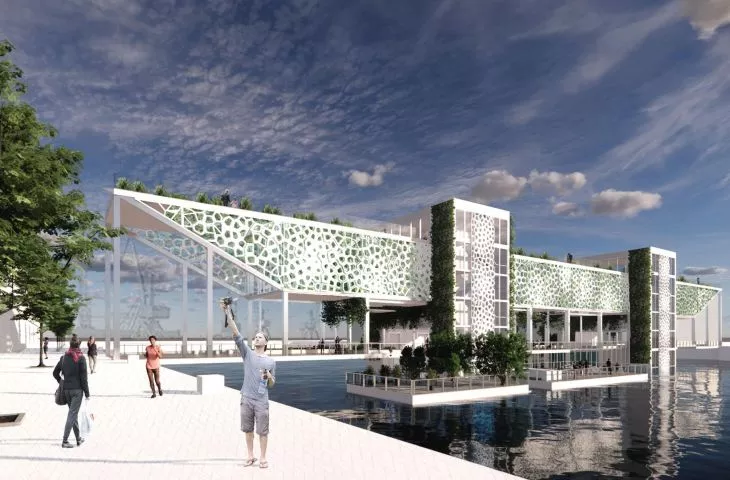A multi-level bridge in Rotterdam filled with a variety of plants, with an underwater patio, a terrace meadow, recreation and work areas was designed by {tag:studenci}, this year's graduate of the Faculty of Architecture at Wrocław University of Technology. Her diploma won an honorable mention in the international competition entitled. "Laka Competition'21: Architecture that reacts".
The "Laka Competition'21: Architecture that reacts" was announced by the Laka Foundation, a non-profit organization focused on social change brought about by architecture and design. Participants were encouraged to use cutting-edge technologies - solutions from robotics, mechanics, digital fabrication and biodesign. They themselves could decide on the location, scale and functions of the designed object. The jury, consisting of prof. Hanaa Dahy (architect and director of the BioMat research team at the University of Stuttgart), Dr. Vasilija Abramovic (architect, researcher and curator of exhibitions at the Interactive Architecture Lab) and Dr. Peter Kuczia (architect and curator of the Design that Educates Awards) judged, among other things.Among other things, the overall idea and implementation, the level of social and environmental commitment of the project, its flexibility and self-sufficiency. Consideration was given to projects that could have a positive impact on their surroundings - society, nature and the surrounding development.
PWr graduate's project is a volume bridge that is a recreation center
© Weronika Graś
green space in the former port
Honorable mention went to Weronika Graś for her project titled. "Bridge the gap: a multi-purpose center, Rotterdam." The work was created under the direction of Dr. Ada Kwiatkowska of the Department of Architecture and Visual Arts at Wrocław University of Technology.
The author proposed the creation of a unique volume bridge that would serve as a recreational center. It would connect the banks in the currently unused part of the Merwe-Vierhaven harbor in Rotterdam. In the plans of Rotterdam's authorities, this part of the city is to become the "Rotterdam Makers District" - a space of lively economic activity with start-ups and companies developing new technologies. It is to be a place with slowed-down car traffic, developed public transportation, a network of bicycle paths and numerous green areas.
bridge fills with greenery
© Weronika Graś
The aim of Weronika Graś's work is to draw attention to the connections between architecture and contemporary civilization problems. The architect focused on the aspect of the disappearance of biodiversity in cities and the responsiveness of architecture with the user.
As Veronika explains:
The proposed solution is a suggestion that in a rapidly developing world focused on the use of technology, we should not forget about very basic solutions, such as access to nature, fresh air or water. In this project, I proposed a new typology of a recreational center. It is the idea that living in a dense urban structure does not at all mean giving up green spaces. Residents can use them as public farms, biophilic coworking spaces or green exhibitions [...]. The presented facility becomes an example of a green, active space that integrates humans with nature. In addition, it highlights the important impact of education on the bioclimatic approach in architecture. Moreover, it is an attempt to manifest the necessity for a more ecological direction of development and transformation from a post-industrial abandoned space into a vibrant, diverse and colorful space.
Biodiversity in the city
The PWr graduate proposed building a bridge filled with greenery. On each of its floors a different biotope would be created. A separate micro-world, with a variety of function, sunlight and atmosphere. In this way, the facility would evolve over time, changing along with the vegetation that would co-create it. The facility could accommodate about 320 people at any one time, and would feature coworking spaces, an exhibition hall, a café, an urban farm and spaces for quiet and relaxation.
A floor with underwater plants
© Weronika Graś
The-2 floor would be completely under water. It is there that visitors would be able to explore the mysterious world of the aquatic biotope. The dark room is bounded by glass walls and an acrylic plexiglass floor. The high transparency of the space provides an excellent view of the underwater vegetation - seaweeds, kelp, water spicules, foliage, paddles and seagrass. Watching the plants, you can feel as if you are diving.
The main structure of the bridge is two steel trusses and steel-reinforced concrete columns
© Weronika Graś
The first floor is the main walking path, serving as a bridge. In addition to crossing to the other bank, pedestrians can rest on the grass and sit on benches arranged around floating and hanging plants. Here one can find water lilies, cattaile, as well as climbing species - ivy, aristolochia or wisteria sinensis.
The next level is filled with indoor plants - monstera, chamedoras, ficus and many others. Together with outdoor green pockets on the facade, it creates a friendly space for working, studying, meeting. From the top floor you can access the roof terrace. It's a bright space full of daylight and beautiful views of the city and harbor. There is a garden with a natural, meadow-like character, overgrown by lavender, daisies and rosemary.
to help the problems of civilization
The facades are designed with glass and hydroceramics
© Weronika Graś
Themain structure of the structure is two steel trusses and steel-reinforced concrete columns. The bridge would extend about three meters above the water surface. Its facade is designed with glass and hydroceramic - a composite material that reacts to heat and water, capable of collecting it from moist air. The architecture also leaves room for user interaction. Using a system of movable platforms, they can adjust the space according to individual needs. As the author says, the project is a kind of manifesto considering the direction of future architecture and a metaphor for the interconnectedness of the user, technology and the environment.













































